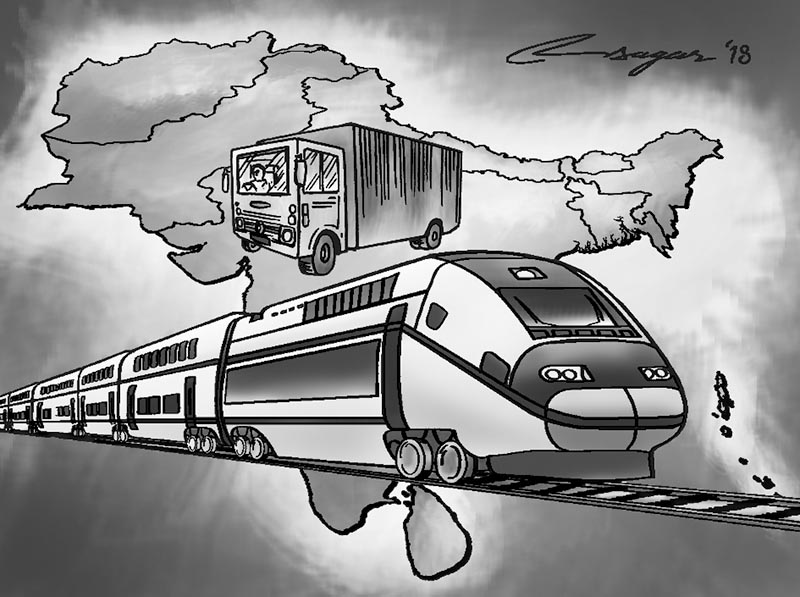SAsia’s transport corridors: Can lead region to prosperity
Booming traffic and trade can make transport corridors financially viable. But the right conditions, such as improving work skills, land use, local governance, as well as providing access to finance for women, must be put in place for corridors to become equitable (impact) investments
No doubt, South Asia’s prosperity was built along its trade routes. One of the oldest, the Grand Trunk Road from the Mughal era still connects East and West and in the 17th century made Delhi, Kabul and Lahore wealthy cities with impressive civic buildings, monuments and gardens.
Fast forward a few centuries and today, South Asia abounds with new proposals to build a vast network of transport corridors.
In India alone—and likely bolstered by the successful completion of the Golden Quadrilateral (GQ) highway system—several transport proposals extending beyond India’s borders are now under consideration.
They include the International North-South Transport Corridor (INSTC), linking India, Iran and Russia, the Asia-Africa Growth Corridor, and the Bangladesh, China, India and Myanmar (BCIM) economic corridor.
The hope is that these transport corridors will turn into growth engines and create large economic surpluses that can spread throughout the economy and society.
Arguably, the transport corridor with the greatest economic potential is the surface link between Shanghai and Mumbai. These two cities are the economic hubs of China and India respectively, two emerging global powers.
The distance between them, about 5,000 kilometres, is not much greater than the distance between New York and Los Angeles.
But instead of crossing a relatively empty continent, a corridor from Shanghai to Mumbai—via Kunming, Mandalay, Dhaka, and Kolkata—would go through some of the most densely populated and most dynamic areas in the world, stoking hopes of large economic spillovers along its alignment.
“Build and they will come” seems to be the logic underlying many massive transport investments around the world.
However, the reality is that not all these investments will generate the expected returns.
Worse, they can become wasteful white elephants—that is, transport infrastructure without much traffic—that would cost trillions of dollars at taxpayers’ expense. So, how can South Asia develop transport corridors that have a positive impact on their economies and benefit all people along the corridor alignments and beyond? First, countries need to change the mindset that transport corridors are mere engineering feats designed to move along vehicles and commodities.
Second, sound economic analysis of how corridors can help spur urbanisation and create local jobs, while minimising the disruptions to the natural environment, is key to developing successful investment programs.
Specifically, it is vital to ensure that local populations whose lives are disrupted by new infrastructure can reap equally the benefits from better transport connectivity.
The hard truth is that the development of corridor initiatives may involve difficult tradeoffs.
For instance, more educated and skilled people can migrate to obtain better jobs in growing urban areas that are benefiting from corridor connectivity, while unskilled workers may be left behind in depopulated rural areas with few economic prospects.
But while corridors can create both winners and losers, well-designed investment programmes can alleviate potential adverse impacts and help local people share the benefits more widely.
In that vein, India’s Golden Quadrilateral, or GQ highway system, is a cautionary tale.
No doubt, this corridor had a positive impact.
Economic activity along the corridor increased and people, especially women, found better job opportunities beyond traditional farming. But this success came at a cost as air pollution increased in the districts near the highway.
This is a major tradeoff and one that was documented before in Japan when levels of air pollution spiked during the development of its Pacific Ocean Belt several decades ago.
Another downside is that the economic benefits generated by the GQ highway were distributed unequally in neighbouring communities. While some adjacent districts become more prosperous, others did not improve as their residents lacked the necessary skills to compete for new jobs, land use was constrained, and local governance remained weak.
In the end, the average impact on regularly-paying jobs, household consumption, and poverty was negligible. While this happened in India, similar stories are common in China and the rest of the world. Sure, booming traffic and trade can make transport corridors financially viable. But the right conditions, such as improving work skills, land use, local governance, as well as providing access to finance for women, must be put in place for corridors to become equitable (impact) investments. Only then can economic corridors become the engines of growth and prosperity for local communities that we all hope for.
Melecky is a lead economist for South Asia at the World Bank






